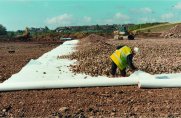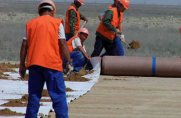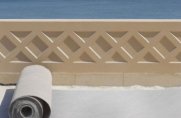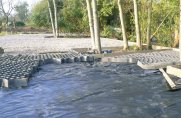- Market Sector
- Application Function
- Products
- Geotextiles
- Geocomposites
- Geocomposite Drains

Geocomposite Drains
Terram geocomposite drains are designed to replace 'traditional' solutions and are highly effective in the collection and conveyance of both liquids and gases. - Salt Barrier Geocomposite

Salt Barrier geocomposite
Developed to prevent damage caused by the capillary rise of saline groundwater into 'sweet' soil zones. - Frost Blanket Geocomposite

Frost Blanket
A purpose-designed, protection geo-composite for mitigating the effects of frost heave. - PW2 (Railway Track-bed Drains)

PW2 trackbed robust separator
A robust separator / filter incorporating a stiff net between two textile filter layers.
- Geocomposite Drains
- Geocells
- Erosion Control

Erosion Control Geocell
Terram geocell is a relatively shallow cellular confinement system which is used to combat erosion on slopes up to 1:1. - Retaining Wall

Soil Structure Geocell
Terram Series 500 Geocell provides a cost-effective alternative to conventional earth retention structures. - Tree Root Protection / Load Platform Geocell

Tree Root Protection Geocell
Terram geocell is a cellular confinement system that is used to protect tree roots from damage caused by heavy vehicles.
- Erosion Control
- Geonets
- Landscape Fabrics
- Consumer / DIY
- Downloads
- About Us
- Contact Us
Terram Geosynthetics are extensively used in civil engineering in the construction of highways - from preventing intermixing of sub-base and subgrade layers, control erosion on cut slopes, for roadside drainage, as part of SUDS projects for infrastructure access and in the construction of retaining walls, bridge abutments and steep slopes.
Improving granular layer performance
Products
TERRAM Standard geotextiles prevent intermixing of sub-base and subgrade layers. This intermixing causes a loss in bearing strength, as the stone layer becomes progressively contaminated, resulting in failure in the form of deformation. This can be remedied if it’s an unpaved area/road by filling the ruts but even this can be uneconomic or unacceptable if stone has to imported over long distances at
a later date.
If it’s a paved road then the intermixing could manifest itself as deformation at the pavement surface e.g. cracking and/or rutting, by which time the damage at the sub-base/subgrade interface cannot be repaired without re-construction and any repairs are cosmetic rather than structural. Better to pre-empt the problem by including a
suitable geotextile.
The geotextile must first be capable of withstanding the rigours of installation. This is when the textile is most susceptible to damage – not during service life. If it is not sufficiently robust, and is capable of tearing or being punctured, then the product is incapable of performing its design function. For example, the filaments of many low-cost, woven textiles can be easily teased apart, even during physical examination. They have little integrity and it is easy to imagine how they will perform when angular stone is placed on them and compacted. A textile filter/separator must have an apparent pore size which remains unaffected by loading. Any openings which are created or widened, or are caused by tearing/puncture, will allow subgrade particles to be pumped through to the sub-base.
Radial load requires isotropic propertiesThe loading from a wheel at the sub-base/subgrade interface is radial and this means that the geotextile should have isotropic strength to deal with it. It is not sufficient for the textile to have high strength in one or two directions as with woven products.
Sustained filtrationThe geotextile must provide sustained filtration whilst also separating the two layers i.e. the textile must allow the free passage of ground water yet limit the passage of soil particles. This involves matching the pore size with the sub-grade’s smallest particle size. This does not mean that the geotextile should have a pore size smaller than the smallest soil particle. It has been established that a geotextile acts as filter by virtue of a natural filter that is formed against the surface of the textile.
The ultimate objective is to maintain the integrity of the granular layer and thus gain the maximum life from the structure. This can be achieved by allowing its maximum bearing strength to be mobilised throughout the road’s width and depth, and throughout its life.
Typical paved and unpaved applications where geotextiles are used beneath granular layers include:
• Highways
• Car parks
• Hardstandings
• Access and haul roads
• Cycle ways and footpaths




































